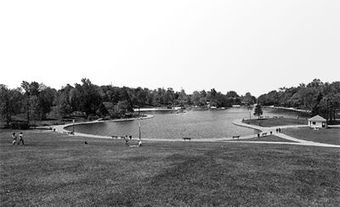Rule Wynn and Rule
Rule Wynn and Rule Architects was founded in Edmonton, Alta in 1938 by John Ulric Rule (1904-78) and Gordon K. Wynn (1910-94) when the two men were unable to find work in existing architectural firms during the Great Depression. The partners were joined the following year by John Rule's brother, Peter Leitch Rule (1913-64). All three principals were graduates of the University of Alberta's architecture program (1920-40). With offices in Edmonton (1938-present) and Calgary (1945-86), Rule Wynn and Rule became an influential western Canadian architectural firm and played a critical role in the establishment of modern architecture in Alberta. Although a series of name changes have reflected changes in key personnel, the existing Edmonton office is one of the longest continuously operating architectural firms in Alberta.
During World War II the firm was left in the hands of the Rules' father, Peter Rule, Sr., a building inspector for Alberta Government Telephones. Although not trained as an architect, Rule, Sr. designed many of the province's telephone exchange buildings. To recognize his contribution to Alberta's architectural landscape, he was granted a special certificate by the Alberta Association of Architects in January 1941. In 1945 the firm expanded to Calgary, with Peter Rule as partner-in-charge.
Rule Wynn and Rule has produced a wide and varied body of work. The firm has received commissions across western Canada, the Yukon and the Northwest Territories, and the large number of projects completed in Edmonton and Calgary have had a cumulative effect on the architectural landscapes of those cities. The Edmonton office has produced designs for such projects as the Georgian style Foster McGarvey Funeral Home (1938), Varscona Theatre (1940), a fine example of Moderne, and the Alberta Government Telephone Building (1953). The AGT Building, Edmonton's first glass box, was designed only one year after Skidmore Owings and Merrill's Lever House in New York became the first glass box built in North America. The firm made a significant contribution to the city of Calgary with its modern designs for the Petroleum Building (1951), Spruce Cliff Apartments (1953), Trend House (1954), Elveden Centre (1959-64) (three towers linked by a podium and the highest building in Calgary at the time) and MacMahon Stadium (1960), among many other projects.
The firm has won numerous awards, including Alberta Association of Architects awards for the Alberta Agriculture Building (1983), Edmonton Centre (1978), Maclean Block renovation (1979) and Weinlos Elementary School (1985) and a City of Edmonton Architectural Award for the Commonwealth Aquatic Centre (1978). Rule Wynn and Rule, Calgary was superseded by Rule Wynn Hames & Partners, W.G. Hames Associates, and Hames & Timleck Architects & Engineers. Rule Wynn and Rule, Edmonton was superseded by the following firms: Rule Wynn Forbes Lord & Partners, Wynn Forbes Lord Feldberg Schmidt, Wynn Hames Forbes Lord Feldberg Schmidt, Forbes Lord Feldberg Schmidt Croll, Schmidt Feldberg Croll Henderson, Henderson Inglis, Henderson Inglis Partridge, and HIP Architects.

 Share on Facebook
Share on Facebook Share on X
Share on X Share by Email
Share by Email Share on Google Classroom
Share on Google Classroom


